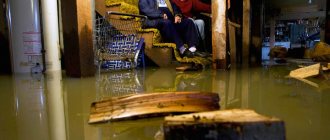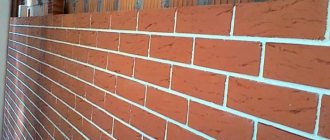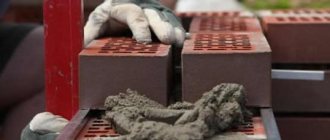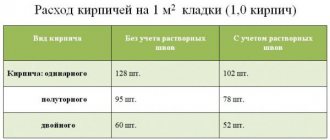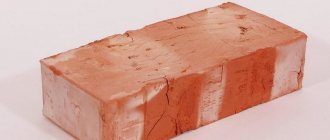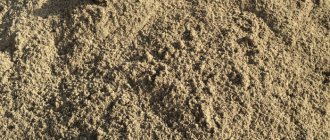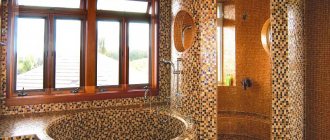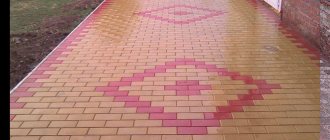Very often, workers have to deal with the situation of completing construction in bitterly cold conditions, which is especially true for the northern regions of the country. This weather pleases many, but not the customer and the builders, since the construction of the building must be completed on time, with the proper quality of workmanship in any conditions. How to make high-quality bricklaying if the temperature outside is sub-zero and long-term warming is not expected?
The opinion of qualified specialists gives good hope with solid statements about the possibility of continuing or completing stone work in such a situation. Brick laying is possible in any weather, subject to special technologies and taking into account certain nuances. Let's take a closer look at the features of brickwork in cold weather.
Difficulties in laying bricks in frosty weather
The difficulty of winter masonry that determines all problems lies in the freezing of the cement mass, or rather the water contained in it. This disrupts normal hydration processes and the strength of the solution loses about a quarter of the required norm. This circumstance leads to inadequate adhesion of building elements, which directly affects the overall stability of the building. It decreases, and this can lead to unpleasant, sad consequences.
In addition, changes in temperature and humidity will cause:
- destruction of the structure of bricks from the process of freezing moisture in them;
— formation of a thin ice crust on the surfaces of the elements being connected;
- the formation of numerous voids in the solidified solution after temperature normalization.
Finding, let alone living in such a house becomes dangerous.
Attention! If you correctly follow some “winter” principles of laying bricks, then there will be no problems with quality construction and the structure will be reliable!
What problems are encountered when laying bricks in winter?
When constructing a brick wall at low temperatures, it is quite difficult to provide the required strength to the object under construction. At low temperatures, the water present in the solution crystallizes quite quickly, forming ice and stopping the hydration of cement. In the case where the water has not yet frozen and has been moved from cold to warm, this can lead to the formation of ice on the surface of the bricks.
As the temperature rises, the ice formed, both on the surface of the laid brick and inside, will melt, which leads to a significant decrease in the adhesion of the brick and mortar. It is also necessary to pay attention to the fact that during the process of freezing and thawing of water, small voids can form in the masonry, which also reduces its strength, and they also lead to the rapid destruction of the structure.
Preparing the solution in winter
Despite the fairly low temperature, bricklaying in winter can be done no less efficiently than at above-zero temperatures if you use a specially prepared mortar.
To perform brickwork in winter conditions, special anti-frost additives must be added to the prepared mortar. It is recommended to use a brand of at least fifty, which already contains all the necessary additives. After completing the masonry, you need to monitor the hardening process of the solution. Why are small holes with plugs left in it to be able to measure the temperature both outside and inside the masonry.
At low temperatures, bricklaying can be done by freezing or by artificial heating.
Construction in winter. Photo
Something to remember! When starting to carry out work, it is necessary to take into account that all antifreeze additives are poisonous, therefore it is necessary to work with such a solution in fairly thick gloves, safety glasses and special clothing. Basically for the same reason, mixtures that use chemical additives are allowed to be used only for the construction of foundations and retaining walls. Laying bricks at low temperatures using special chemical mixtures is prohibited for the construction of residential premises.
Laying methods in winter conditions
Brick laying at low temperatures is most often carried out in the following ways:
- Freezing method
The most effective laying of facing bricks is carried out in winter, if it is done using the freezing method.
High quality brickwork. Photo
The meaning of this method is that the cement mortar used for masonry in the winter can set again some time after it thaws. When using this method, the solution must be completely, and the brick must be completely free of frost. If ice has managed to form on the bricks, it must be removed using a torch. Also, when using this method, it is recommended to use the highest grade of solution. The solution can cool quite quickly and, as a result, ice crystals can form in it, so it is advisable to use the heated solution within half an hour at most. To prevent the solution from freezing, it should be diluted in small portions.
Electric heating of masonry. Photo
- Electric heating
Since this method is energy-consuming and quite labor-intensive, it is recommended to use it only for the construction of small areas. During the masonry, electrodes are placed in the finished laid mortar in a horizontal position, through which, after the masonry is completed, an electric current will be passed, during which these electrodes will heat up and heat the seams, eliminating the possibility of ice forming in the laid mortar. However, in order to effectively use this method, it is very important that the seams between the laid bricks are filled sufficiently tightly.
Covered object under construction with a greenhouse
- Construction of a greenhouse
This method is quite effective, but too labor-intensive. Its essence is as follows: a slatted frame is constructed around the wall being constructed, which is completely covered with some kind of covering material or plastic film. Heat generators or any heat sources are installed inside the covered frame to provide heat to the structure under construction and the mortar prepared for masonry.
In order for bricklaying to meet the required standards in winter, the equipped greenhouse must be heated for several days. This heating method is only suitable for the construction of individual elements, since it is practically impossible to build a frame greenhouse over an entire house.
Final work
After completing the construction of the wall no higher than the level of the first floor, you need to lay prefabricated floors. If the freezing method was used when laying bricks, then the height of the structure being built at low temperatures should not be higher than 15 meters.
After completing the construction of walls in winter, it is necessary to remember that after the arrival of the spring thaw, it is important to observe the laid masonry, and the walls located on the south side must be moistened or covered with glassine.
Watch the video on how to mix masonry mortar in cold weather
Recommendation! During laying, it is necessary to control the state of the mortar, namely, the course of its hardening. For this purpose, several special plugs are placed in the concrete , in which the temperature is measured with a thermometer (4 times a day)!
However, the use of additives is unacceptable in the construction of residential buildings, as they contain toxic compounds that are very harmful to humans. Therefore, antifreeze additives are added to the cement mortar of foundations or masonry mixtures for non-residential and auxiliary buildings. Each worker must use protective equipment, devices and special clothing.
Some builders, in order to save money, add liquid soap to the solution. This component reduces the total amount of water in the solution. After thawing, the soap composition does not affect the hydration of cement, but the number of voids, delaminations and cracking of bricks is significantly reduced.
Brickwork in winter conditions
In some cases, the construction of a house or building may be significantly delayed and will have to be continued during the winter. There are many reasons for the delay: lack of building materials, finances, insufficient speed of work, small construction personnel or the scale of the project. However, this is not important. The main thing is that masonry can be carried out in winter, you just need to follow certain rules and take into account some features. We will talk about them in this article.
Carrying out brickwork in winter
When planning the construction of brickwork in winter, take into account the temperature regime, as well as everything connected with it. For example, simple cement mortar cannot be used at temperatures below +5 degrees. The fact is that the composition of the masonry mortar includes cement, sand and water, and the latter freezes at subzero temperatures, which becomes a serious obstacle. There are several methods to influence the solution to increase its frost resistance. With their help, bricklaying in winter became possible.
Let us note the main list of measures that should be taken to carry out brickwork in the winter season:
- Construction of a greenhouse. You can insulate an object using wooden formwork and a special film that keeps the temperature inside the room above zero. Since during the solidification of the solution, heat is released that needs to be retained, this will further increase the temperature under the film, although only slightly. To ensure that the temperature is always above +5 degrees, heating devices and air guns are used to heat the air inside the greenhouse.
- Anti-frost modifiers for masonry mortar. Brickwork in winter is often carried out using chemicals that do not allow the water in its composition to quickly freeze. Most often these are chemicals, which we will talk about in more detail later.
- Heating masonry using electricity. In this case, brickwork should be carried out with special electrodes, which are represented by metal wire. It should be inserted into the masonry and connected to a power source. An electric current passing through the wire causes it to heat up, so the solution does not freeze. The solution maintains normal temperature conditions necessary for high-quality setting.
- Heating the masonry mixture. It is based on the fact that the brick is placed on a preheated mortar, which has time to go through the initial setting stage. After thawing, the setting and hardening of the solution continues. It is heating the mortar that is the most common measure when carrying out winter bricklaying.
You need to choose one method or another in advance, taking into account the weather forecast for the coming week, as well as the current temperature conditions. It is vitally important to take certain measures to create an optimal regime for shrinkage and setting of the mortar, because otherwise the masonry will simply crumble.
Consider the possibility of combining several methods of dealing with low temperatures. Do not forget about the purpose and location of this or that fragment of masonry, since the possibility of using chemical additives that are harmful to human health depends on this.
Now let’s look at each of the listed measures to combat frost in more detail.
We build a greenhouse with our own hands
This method is relevant only when constructing small objects:
- Cottages;
- Country and country houses;
- Boarding houses;
- Recreation centers;
- Saraev;
- Garages;
- Workshops and summer kitchens.
It is clear that it is unrealistic to cover a multi-story building with a greenhouse. Even if you try to do this, the cost of building a greenhouse will be unreasonably high.
We also note that you can build a greenhouse yourself, using available materials - boards and remains of formwork, construction waste, etc. Here you can show your imagination, and everyone will have their own method. It is important to create a high-quality barrier between the indoor space and the cold air outside. For this, an electric heater is used; less commonly, a diesel or gasoline unit or a heat air gun are used.
For large-scale construction, this method is not used, since too much material and energy are wasted on heating the interior.
The method of building a greenhouse came from concrete work. In this case, with large volumes of concreting, the reaction that occurs in the hardening solution leads to the release of a large amount of heat. This is quite enough to warm up the entire building. The main thing is that the heat does not dissipate; this is why they build a kind of thermos around the concreted object. Certain elements of the shelter require storing bricks in winter. The brick is covered on all sides so that there is no exposure to cold wind.
Application of frost-resistant additives
A modifier is first added to the solution, which lowers the freezing point of the water included in the mixture. At the same time, the additive helps speed up the setting process and quite often has several properties. Most often these additives are:
- Calcium nitrite;
- Sodium chloride;
- Sodium nitrite;
- Calcium nitrite with urea;
- Potash.
The scope of application of chemicals is very narrow. If the building is residential or public, it is not recommended to use chemical modifiers in the masonry of brick load-bearing walls, as well as interior interior partitions, as they are toxic.
Potash has found application in the construction of external structures. Calcium nitrite and urea (NCM) are used for the same purpose. The mass fraction of potash in the masonry mortar should be from 5% to 15%. Thanks to the additive, the solution can be used at temperatures down to -30 degrees. The mass fraction of NCM in the solution ranges from 2% to 10%, and the solution does not harden at temperatures down to -14 degrees.
Remember that an increased concentration of additives leads to premature setting of the solution. To slow down this process, sulfite-yeast mash is used in an amount of 1% to 3% of the total mass of the solution.
Heating with electricity
Wire with a thickness of 0.3 to 6 mm is laid on the horizontal seams of the masonry, which is then connected to a source of electricity and heated. In this case, it is necessary to properly fill the vertical seams, otherwise the heat transfer will occur too slowly.
Electricity consumption ranges from 95 to 180 kWh m3. Heating the solution takes no more than 25% of the heat generated by the wiring. The rest of the heat goes to heating the brick itself, as well as the surrounding air. This method is not highly effective, although it is more practical and simpler than constructing greenhouses.
When using electric heating, the presence of a specialist is required, who is able to select the correct electrode connection scheme and calculate their thickness (depending on the voltage of the power source and current strength).
Methods for laying bricks at low temperatures
In addition to the use of anti-frost additives, there are a number of other effective methods that allow you to build brick buildings in cold weather. Let's get acquainted with the most used and available technologies.
1. Electric heating of the mortar - involves installing a system of metal electrodes in the masonry being created, which will heat the hardening mortar and bricks. In the intervals between them, a controlled electrical short circuit will be created with the release of a sufficient amount of thermal energy.
The construction technology consists of equidistant placement (checkerboard pattern) of metal rods with a pitch of 21.0–23.0 cm in every second horizontal layer of mortar. Then, the protruding ends of the electrodes are connected into an insulated system - one layer - one electric pole. This way, you will get a uniform alternation of electrical connections over the entire area of the wall, the thickness of which will determine the amount of current supplied. For example, a connected voltage of 220 volts will heat a wall one and a half meters thick to + 3o degrees. Therefore, for normal heating of a 50.0 cm wall, about 74 volts must be supplied. However, accurate calculations must be carried out by specialists, taking into account all the features and characteristics of the materials.
Contact will occur through the mortar and wet areas of the bricks. These places will begin to be constantly heated, and the heat will spread evenly over the area of the entire masonry, forming a comfortable oasis for normal hydration (hardening) of the fixing composition.
Brickwork in winter with additives
This method is based on lowering the freezing point of the masonry mixture, which allows it to harden at negative values on the thermometer. Therefore, by the time of freezing, the mortar composition will gain up to 20% of its design strength.
If brickwork in winter conditions is carried out with the addition of anti-frost additives to the cement mortar, then the brick laid in the case should be cleared of ice and snow. The masonry mixture must be positive t, which is calculated based on the air temperature.
For above-ground masonry, potash and sodium nitrite are mainly used. An exception to the use of potash is silicate masonry, which will be operated in conditions of humidity greater than 60%.
When using potash, it is necessary to take into account its effect on the rate of thickening of the mortar composition. To prevent this, an additional retarder of the setting process (sulfite-yeast mash and others) is added to the solution.
Sodium and calcium chloride salts cause efflorescence on masonry. In this regard, they are used for laying foundations made of rubble concrete or rubble, and also when strict requirements are not imposed on the quality of the masonry surface (warehouse buildings, for example).
The amount of anti-frost components introduced into the mortar composition is calculated taking into account the expected temperature of the air in the next 10 days after masonry work. Additives are introduced together with water when preparing the masonry mixture.
Today there are many modern antifreeze additives and plasticizers, often two in one at the same time. These are, for example, Cascade Eco, Plastol-M and others.
Electric heating of masonry
Steel wire or special electrodes are used as a heating element
It is most often used for small areas made of brick. Steel wire or special electrodes are used as a heating element. The conductors are installed in the masonry joints with a small pitch (40-50 cm), after which the electrical wire terminals are connected to them. The latter are connected to the power grid. A current flows, which heats the wall until the solution sets.
Important: a special steel mesh can be used as a conductor and heating element, which is attached to the outside of the walls. This method is quite expensive and time-consuming.
And a few more important recommendations for winter masonry
If anti-frost additives and plasticizers will be used, then it is better to use cement of a grade not lower than M-300
- When performing construction work in frosty and snowy cold weather, you should not count on the quality of masonry, which is inherent in summer construction manipulations. At the same time, the budget expenditure for construction will be approximately 30% higher than in the summer.
- If anti-frost additives and plasticizers will be used, then it is better to use cement of a grade not lower than M-300. This will improve the setting characteristics of the solution.
- If brick walls are being built for premises that will be used at high humidity (sauna, bathhouse, etc.), then adding anti-frost impurities to the solution is prohibited. Such a mixture of sand, cement and additive will lose its strength characteristics.
- The thickness of the mortar joint should not exceed 12 mm during winter laying. If the seam is thicker, then when it thaws it may not perform well, which will affect the integrity of the walls made of brick blocks.
- The speed of laying bricks should be higher than installation in the summer.
- If work was suspended until the next day, and it is frosty outside, then when the process is resumed, the upper rows of the wall should be warmed up. To do this, you can use a hair dryer or hot water.
- At the same time, when completing a stage of work, even in the middle, you should always insulate the top row of masonry. This will save time on defrosting.
- It is necessary to strictly control the temperature of the solution used. So, at an outside temperature of -10, the masonry mortar should have a temperature of +5 degrees. If the frost is from -10 to -20, then the temperature of the solution used should be from +10 degrees and above. If the frost is -20, laying is not recommended. When the temperature is -30, construction work is prohibited.
- When laying using the freezing method, it is forbidden to save on the armored belt. And in window and door openings it is better to make monolithic reinforced concrete floors.
- If the installation of windows and doors will be carried out in winter, then a gap of 1-1.5 cm should be left for adding walls.
- In addition, when using winter masonry methods, it is worth constantly monitoring the level of the walls horizontally and vertically. And for a stronger solution with potash, you can add clay paste to it to enhance the plasticity of the mixture. The paste is added to at least 40% of the total mass of cement used.
Remember, following all of the above recommendations will allow you to easily lay brick blocks into a beautiful, strong and durable house, even at sub-zero temperatures.
Methods for winter bricklaying
To ensure that a house made of brick at sub-zero temperatures remains strong and durable, five common technologies are used
To ensure that a house made of brick at sub-zero temperatures remains strong and durable, five common technologies are used:
- Method of heating masonry with electricity;
- Construction of thermal protection around brick walls;
- Thermos method;
- Addition of chemical frost-resistant additives;
- Frozen solution method.
Each of the methods may be relevant in one case and completely unacceptable in another. Let's look into everything in more detail.
